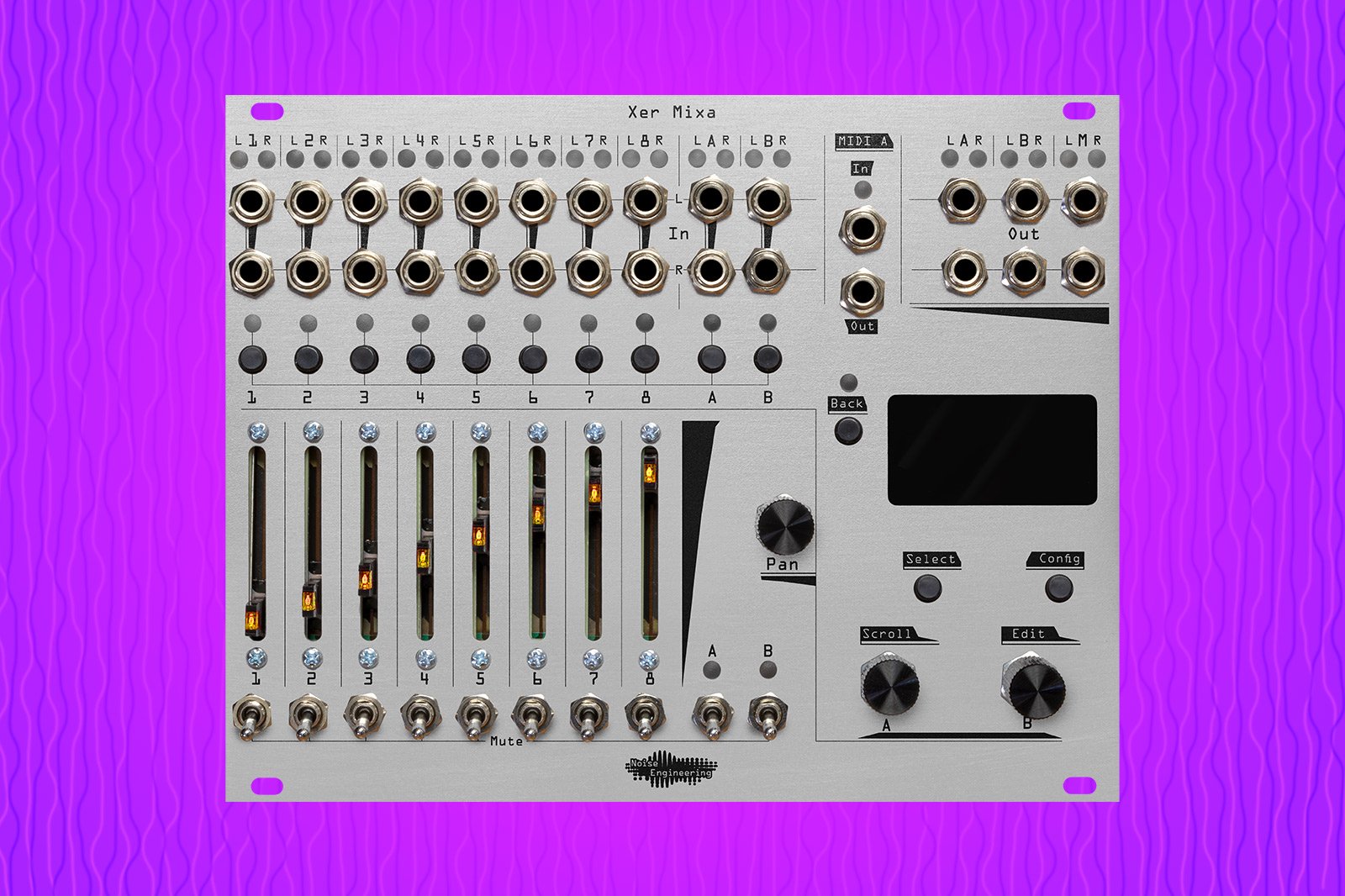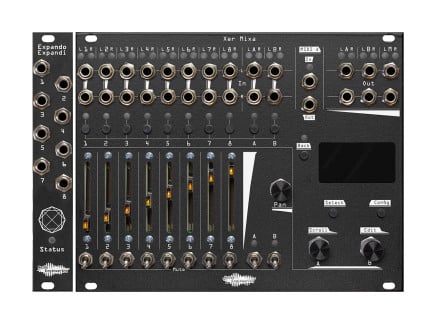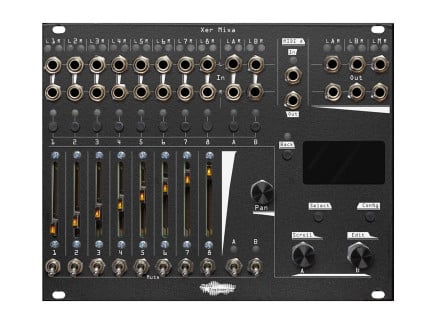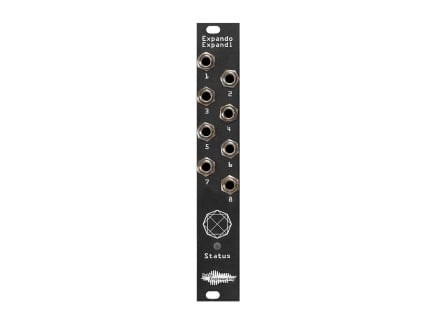Noise Engineering has a knack for, well, designing game-changing music-making tools. From the ever-popular (and recently discontinued) Basimilus Iteritas Alter drum synthesizer module to their Versio series of re-programmable modular effect processors, they've provided countless musicians with deep, inspiring, and downright fun tools.
Of course, a well-balanced modular synthesizer is about more than flashy/exciting sound sources and effects. Some modular designers never look beyond creating novel sound generators and processors, but every modular synth needs utilities like voltage processors, modulation sources, and—of course—mixers. Naturally, when you're buying a modular synthesizer, it can be difficult to motivate yourself to spend money on utilities, as they may not have the same immediate flair as a new sampler or filter or delay. In addition to their more obvious flagship products, though, Noise Engineering does a heck of a job of designing utilities that are every bit as fun and inspiring as the hottest new oscillator.
The latest example? The new Xer Mixa: an eight-channel stereo mixer with a fully analog signal path and thorough digital control. Xer Mixa offers three assignable pairs of stereo outputs, two stereo aux input channels, full state storage/recall, thorough MIDI implementation, and CV control via the optional Expando Expandi expander...the list goes on. Xer Mixa isn't only Noise Engineering's most ambitious module to date—it's perhaps one of the most interesting and powerful mixers in Eurorack altogether. Moreover, it could easily become the center of performative interaction, with plenty of hands-on control and many opportunities for interesting macro control.
We recently reached out to Noise Engineering to congratulate them on this rad new module, and they graciously offered to answer some of our questions about how it came to be altogether. In the following interview, we hear from Noise Engineering's Kris Kaiser, Stephen McCaul, and Markus Cancilla—each describing in turn what makes this such a special and exciting tool for electronic musicians.
Noise Engineering on Xer Mixa
Perfect Circuit: Tell us the story of how Xer Mixa came into existence. In the manual, it's hinted that this module has been in the works for quite some time—even before Noise Engineering formally existed. Sometimes great ideas need to bake for a while before they're ready, whether by choice or circumstance—what made now the right time to release Xer Mixa?
Kris: It was a culmination of things, really. We thought there would be demand for a mixer like this, and it filled the gaps we were missing collectively as a team. In addition, we had been hamstrung by the lack of one part that we needed: the DAC for the digital control interface. Our options were limited because there were so few available and they were all expensive during the height of the pandemic. Near the end of 2022, we stumbled on a part that was available, inexpensive, and ideal for our needs. Everything fell into place after that. We had a design and a near finished prototype in February of this year. The only real changes from that prototype were a few slight layout changes and some more cleanup to improve SNR.
PC: What features were present in Xer Mixa from the start? Were there any additions along the way that seemed useful at the time but didn't end up on the final design? What about features that you ruled out early on?
Stephen: Early versions had line level input and output. There were a lot of early versions that had very different routing. There was even a modular version where the channels were all independent modules. The final feature set was really built around a balance between interactiveness and total size.
Kris: And really what we thought most of the likely customers already had in their case. We knew this was going to be expensive, and we went into this design trying to make choices that didn’t duplicate functionality that a lot of customers already owned (e.g., headphone outputs, line-level amplifier). For those who want that feature, why should they pay for something they already have? For the same reasons, we ruled out adding effects. It would have been extremely expensive to add them, but also, the joy of modular is being able to change your signal routing to whatever suits your mood that day. Built-in effects defeated that purpose to us...which turned out just fine since we ran out of memory on the processor and couldn’t have fit effects if we tried.
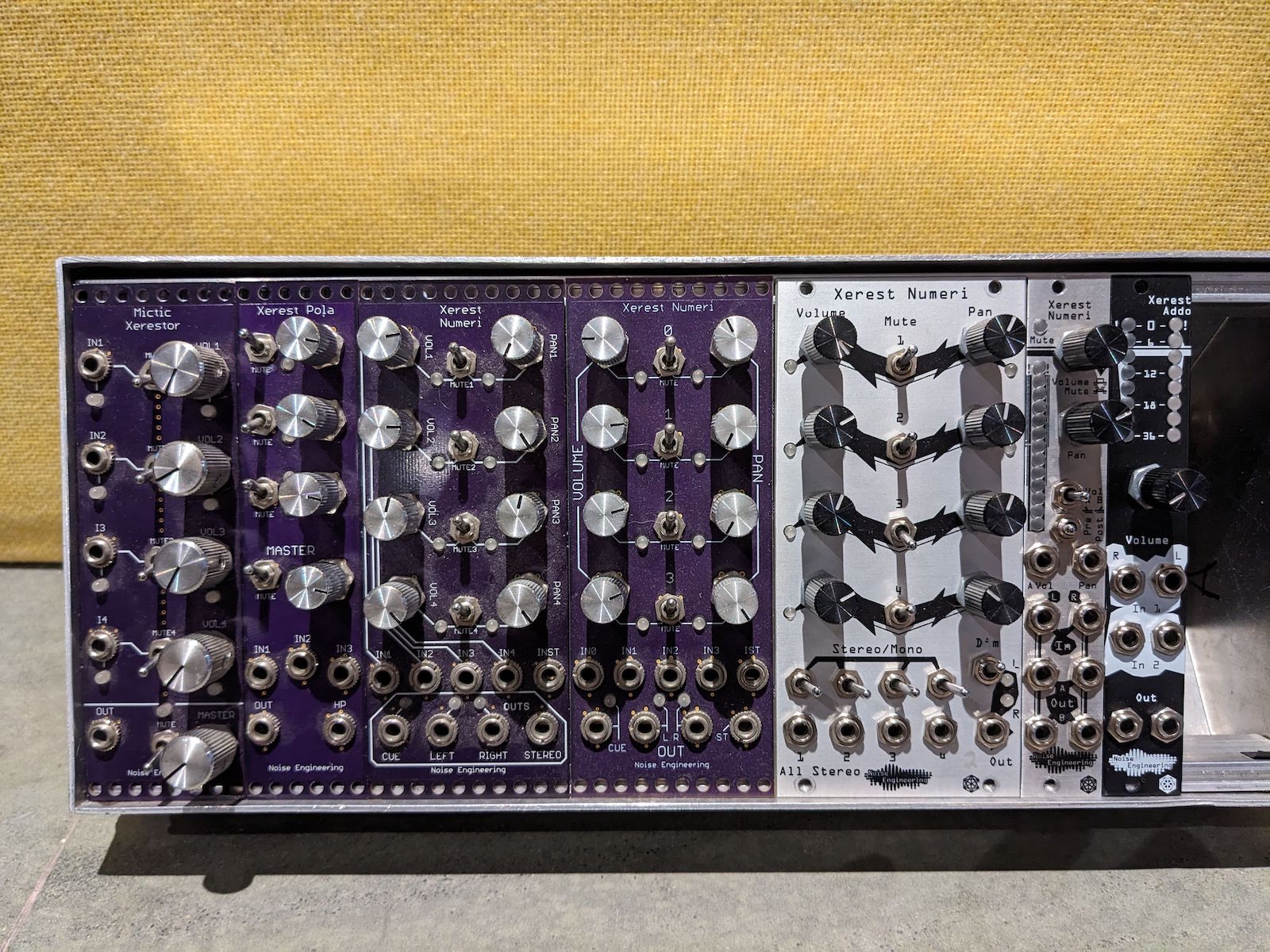
[Above: several generations of prototypes that preceded the current Xer Mixa design—image courtesy of Noise Engineering.]
PC: Xer Mixa features a unique hybrid design utilizing an analog signal path subjected to exacting digital control. What made this approach so appealing compared to just designing a mixer that was fully analog or fully digital?
Kris: An all analog-signal path gave us a lot of perks like high headroom and great sound quality, but the digital control meant that we could do things like save state and have complex CV routings. We could add MIDI. We could let users route signals in complicated ways. We could lean into modular synthesis in ways that people didn’t immediately expect, but be flexible about it. Instead of real estate dedicated to a single function, Expando Expandi can be used for virtually anything: add CV, turn channels into VCAs, create mute groups, modulate channel panning…
PC: Xer Mixa is your biggest module to date, the first device you've released that includes a screen, and possibly the most elaborate "hybrid" device in your lineup far. We're curious—did the hybrid design of Xer Mixa lead to any unique technical or conceptual challenges during development?
Kris: It was less the hybrid design and more the screen that was the challenge! We built various designs of Xer Mixa, and had previously released a couple of analog mixers, so the circuitry didn’t hold a ton of unknowns (notice I didn’t say it was simple), but the screen caused us a lot of grief while we worked to isolate the noise and decrease its power consumption.
PC: Choosing a mixer (or mixers, plural) for your Eurorack system can be a surprisingly personal decision, given the inherently modular nature of the platform and the number of different workflow preferences that someone could have. At a glance, Xer Mixa seems like it was designed for performance-oriented systems with multiple voices and stereo signal paths. Would you agree with that perspective or care to elaborate on Xer Mixa's strengths?
Markus: All of our modules are designed, at least in part, with performance in mind. Keeping Xer Mixa compact was a huge consideration, and a big part of why we decided to put the CV inputs on optional expanders: if you’re not using mixer CV in your performance patch, you can save 4 or 8 HP. Keeping options open for the ever-more-stereo Eurorack landscape was important to us, too: we gave every channel stereo inputs for this reason, but you can use it with purely mono sources and effects loops as well.
As you can see from our videos, Xer Mixa is very much at home in a compact performance system, but a 10 stereo in/3 stereo out mixer is quite helpful in a big studio case, too. Whether it’s used to create a final mix for all of your sources or as a CV-able three-bus submixer for additional processing, it’s a very useful mixing and routing tool for many applications.
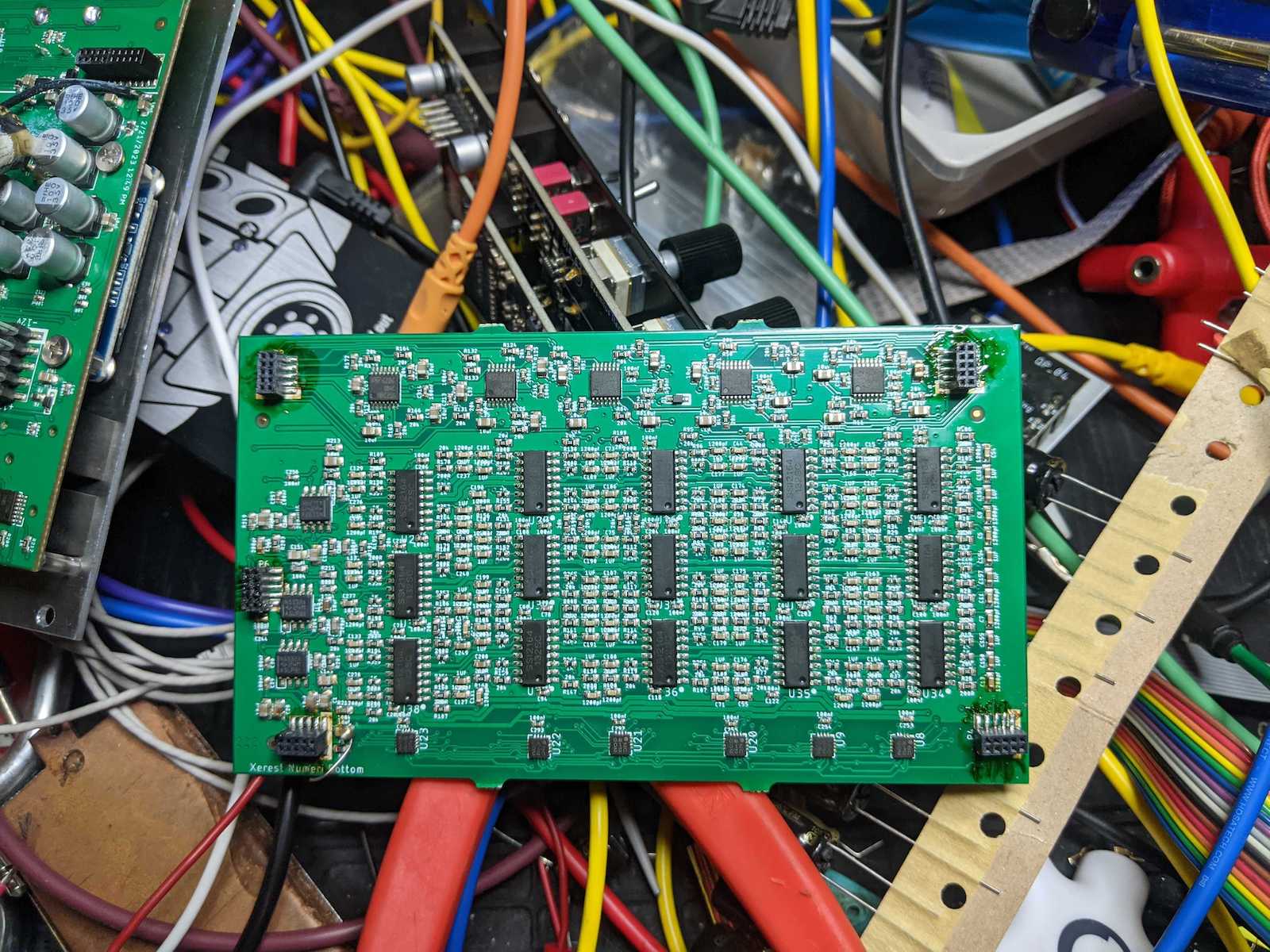
[Above: a late prototype of the Xer Mixa analog board. Image courtesy of Noise Engineering.]
PC: How did you determine which settings would be available as controls on the front panel vs. settings in the menu? Certain parameters, such as channel volume, make total sense to have dedicated faders on the module. Was it a balancing act of deciding what was useful in immediacy vs. set-it-and-forget-it?
Markus: There are a lot of mixer parameters that we wanted to have, but aren’t really useful to adjust in a jam (like channel pan law or MIDI settings), and those were relegated to the configuration menu. Even so, the menu system was designed to be shallow and quick to navigate whenever you do need to change something.
Interestingly, the encoder system opened up a lot of options for performance; to adjust a channel’s effects sends and pan, you tap the channel to select it and the encoders become dedicated controls for those parameters. And since you can select multiple channels at once, it’s possible to adjust, for example, the send level of 5 channels at once to create a big swell with a single parameter – that’s something that you couldn’t do if each channel had individual send knobs.
PC: Given the number of parameters available, Xer Mixa allows you to save configurations as scenes for easy recall. What are some scenarios where you've found scenes to be useful? Any surprising applications?
Markus: Xer Mixa saves your settings as you go so that the mixer will be in the exact same state if you power cycle your case. However, I’ve found it quite useful to use scenes to save different expander configurations; with 32 CV routing slots they can become quite complex, and I have a few favorites that I like to have saved as presets for various patches.
Kris: Markus mentioned that we designed this around performance, so no surprise here, scenes are also nice for performance. It’s a nice way to swap things around on the fly with just a couple of button clicks (or via a MIDI program change).
PC: Alongside the release of Xer Mixa is Expando Expandi, an 8-input CV expander that can be mapped to nearly any of Xer Mixa's parameters. Of course, this not only exposes the less-immediate parameters but opens up all kinds of modulation opportunities. What have been some of your favorite ways to use external CV with Xer Mixa?
Markus: I’m big on techno and dance, so the first CV input on one of my Expando’s is always routed as an inverted CV to most of the channel volumes. This makes it easy to create sidechain ducking effects with a single decay envelope, and makes lots of space for a punchy kick in the mix.
Another place I’ve had a lot of fun is CV over mutes: the mutes are clickless, and patching clock dividers and gate sequencers into the Expando and routing the inputs to different channel mutes is a fantastic way to create long-form arrangements in a big patch.
A single slow LFO modulating pan on a few atmospheric channels is always a great effect, too. The CV inputs can be offset and attenuverted internally, so one modulation signal can affect different channels in very different ways.
PC: The inclusion of MIDI I/O is something that's not typically seen on a mixer—yet it makes total sense and is something that a lot of people might not realize could enhance their workflows. We can imagine the appeal of not only connecting external controllers but also mapping out automation in a DAW. Was this something you knew should be a part of Xer Mixa early on, or did it grow out of internal testing and discussion? How are you making use of these features, personally?
Markus: MIDI was added quickly after we decided on the final form factor. With so many hands-on controls and internal parameters, adding MIDI support was a relatively easy task that opened up a lot of possibilities.
There are a lot of potential applications, but being able to record and playback a mix performance without printing audio is a very useful tool in the studio. It also makes it possible to create a multitrack recording of a performance alongside your stereo mix by multing your inputs to an audio interface, recording all of the mute and level changes as MIDI CCs, then applying that to track level and mute in the DAW after you make any final mix edits.
MIDI has also made its way into more and more modules. If you have a MIDI controller that outputs CCs, you can easily add extra parameters to Xer Mixa, and if you have a sequencer that outputs MIDI it’s another great way to add movement to a patch.
PC: Between MIDI support and compatibility with Expando Expandi, Xer Mixa feels a bit like a statement—are you expressing your opinion that mixers can and should be as dynamic and modulateable as any other part of a modular system?
Markus: After being in modular for a while, I realized that my system mixer was my single most used module out of everything I own. Mixers are also incredibly hands-on performance tools (even outside of modular—look at dub production, for example). Xer Mixa takes all of that into consideration, and tries to make mixing fun, flexible, and enjoyable. Even things like high headroom and straightforward panel controls mean you don’t have to think too hard about your mix if you don’t want to—or, you can create complex CV routings that fully integrate Xer Mixa into your patch and the rest of your studio.
Kris: We don’t like to tell people how to use things. It’s part of why we use the tongue-in-cheek names we do. I’d call this less of a statement on how we think people should use something, and more of us trying to give people options to use things in as many ways as possible.

